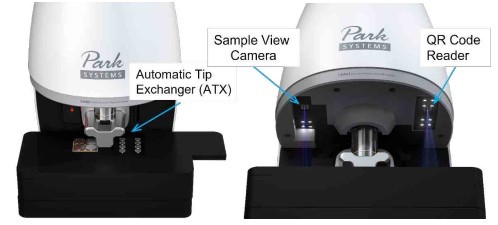Designing a New Class of Atomic Force Microscope –Park FX40 The Automatic AFM
- 13 Jan 2022
- Volume 23
- NANOscientific Magazine, Park Systems Special Edition
Product Line Renewal Every Decade
A decade is sufficient for market disruption and adaptation in Atomic Force Microscope (AFM) industry. Park Systems Corp. (Park), a manufacturer of AFM, has introduced a new major platform every 10 years. Features and capabilities of the first product foretell the product and business strategy of coming decade. Building on the crosstalk elimination design of the XE-series AFMs, Park tapped into the industrial automation market and entered the hard disk market. With the lower noise design of the NX-series AFM, accurate measurement data on large samples became possible, and Park entered the semiconductor industry. Our goal with the groundbreaking user interface in AFM automation, is that the FX product line will enable a new breed of AFM solutions to capture opportunities of major stake against established microscopy industries such as electron or optical microscopes.
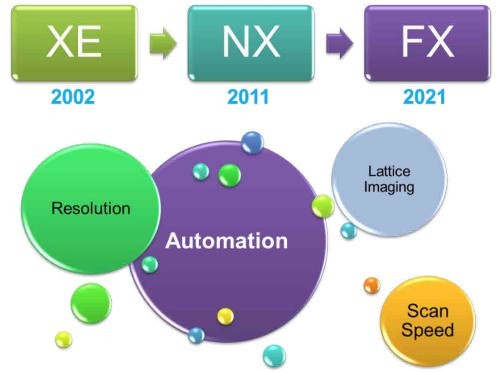
Figure 2. How Park will contribute to market conversation of AFM industry. Automation is a major central theme in Park’s R&D efforts, followed by system performance in resolution. Other agenda such as lattice imaging and scan speed are considered for specific sample and measurement needs.
Is AFM Easy to Use?
The purpose of AFM is to measure surface topography and other physical properties repeatedly and reliably in three dimensions with sub-nanometer resolution. Sample preparation is minimal, if any, and cost of ownership is low compared to related techniques. This has made AFMs indispensable tools in industrial and research applications. However, wide scale acceptance of AFM was previously hampered by complex operation and handling. Although commercial AFMs have been improved over time, AFM is still difficult to learn and operate for many prospective new users with no prior experience. Traditionally, AFM operation required manual input and setup from the researcher. Before obtaining any AFM data, a user must select a suitable probe, load it into the AFM system often using tweezers, and align the optical detection system and viewing optics. This is followed by loading a sample and selecting one or more areas to image and analyze. The user then must select an imaging mode, tune the system, and guide the AFM tip to within detection range of the surface. To obtain valid surface information, the user must tell the AFM how to track the sample surface. These rather complex procedures have prevented AFM from entering mainstream as it generally takes a very experienced person to obtain good, reproducible data. Enhanced user convenience and higher performance can be the two differentiating benefits that may justify Park’s new product line. Enhanced user convenience primarily constitutes motorized and automated steps of tool operation. Higher performance, on the other hand, would imply better specification or additional capabilities of a given tool function to the justified and demonstrated benefit of a user. While AFM makers are competing on resolution, scan speed, or even lattice imaging, Park recognizes automation as the key request for AFM, which will disrupt and grow the market.
FX: The Dream Machine Project
Park FX40 AFM was the dream machine project with the goals to maximize user convenience while adding features and increasing performance. For user convenience, full automation of probe exchange, beam alignment, and sample positioning were targeted from the very early stage of product design. Performance-wise, system noise floor, servo performance, and optical vision were further optimized from previous engineering platforms.
Park FX40 was developed based on the experience gained using crosstalk elimination on the previous generation of Park AFMs [1]. The systems utilize two dedicated, fully independent, flexure scanners, one for sample (XY) and the other for probe (Z) movement. The raw out-of-plane-motion (OPM) before image correction is less than 2nm over 80mm scan range, enabling precise measurements without being impacted by common leveling artifacts. Proven successful in the previous NX- or XE-series, the Optical Microscope Assembly of Park FX40 is positioned in the center of the system. The AFM head is positioned along the center-axis of the Optical Microscope Assembly and moves with the Z stage. The sample chuck and the XY scanner on the XY stage are positioned right below the AFM head.
The Optical Microscope Assembly is attached to the focus stage and can move vertically. Unlike the existing NX-series AFM system, the focus stage is not attached to the Z stage but rides on a separate optics stage. This arrangement reduces the weight on the Z stage, increasing system stability and immunity to external vibrations. In combination with a sturdier Z stage built on a high stiffness crossroller guide and two bearing blocks, the Park FX40 achieves a lower mechanical noise floor than the previous NX-series and XE-series AFM systems. Additionally, the optics stage moves the optical microscope assembly in XY plane, a design consideration important for AFM automation.
The main components of the Optical Microscope Assembly are the same as prior XE- and NX- generations: objective lens, tube lens, camera, and LED light source for vision. The difference is a fibercoupled super-luminescent diode (SLD) which is attached on the side port of the Optical Microscope Assembly. The SLD beam is focused by the objective lens onto the AFM cantilever and is always fixed at the center of optical vision. The objective lens enables the FX40 to generate a very small target beam spot size enabling the use of a wide range of cantilever sizes and applications.
Optical vison quality, an important aspect of industrial automation, was improved compared to the NX-series AFMs. In the FX AFM head design, all obstructing elements, such as beam splitter, present in the previous designs were eliminated to optimize the optical beam path. Line pairs with width less than 1 µm can be resolved in optical vision of Park FX40.

Figure 3. Front view of Park FX40. The view on the right reveals some major components normally hidden by the microscope housing. Figure 4. The Optical Microscope Assembly is decoupled from the moving plate of Z stage, reducing total Z-stage mass. Fiber coupled SLD is attached to the Optical Microscope Assembly. SLD beam is focused through objective lens and always fixed at the center of optical vision.
New FX Features
Park FX40 has the most advanced AFM design and interfaces for user convenience. High-level automation is the central design consideration that includes automatic probe exchange and SLD beam alignment with a click of button using pattern recognition. Inside FX40, there are three camera modules: 1) a main view camera at the system center, 2) a sample view camera on the left side of the system, and 3) a QR code reader on the right side. On the right side of the XY stage, there is the automatic tip exchanger (ATX) module that can hold up to 8 AFM probes. A sliding protective cover prevents foreign objects from dropping into the ATX module when it is not in use.
Probe Loading
Probe loading has been viewed as the biggest barrier for entry users of AFM. The NX- or XE-series AFM systems addressed some of the challenge by using premounted tips [2]. In Park FX40, new probes can be easily and safely mounted at once using an 8-probe cassette. Once the probe cassette is loaded onto the ATX, the probes are ready for automatic probe exchange by the AFM head. Individual probes can be also replaced manually and mounted onto a probehand by the user, just like in the XE and NX series of AFM.
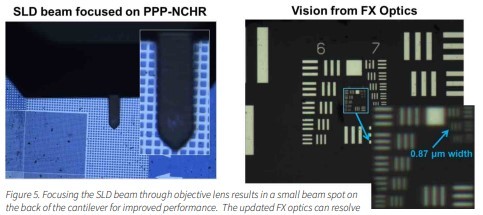
Figure 5. Focusing the SLD beam through objective lens results in a small beam spot on the back of the cantilever for improved performance. The updated FX optics can resolve 0.87 µm linewidth.
Probe Exchange
In similar fashion to the automatic probe exchange on Park’s industrial inline AFMs, probes are picked up by a magnetic force control mechanism [3]. The QR code reader recognizes the probe ID and the status of ATX slots. A vision recognition-based machine learning algorithm automatically detects whether probes are loaded onto their correct positions of the designated probe slots and generates a status report if there is an error during probe loading. The machine learning algorithm analyzes and weighs several factors, such as the shape of Park’s patented chip carrier and loading position, to control and monitor successful or unsuccessful routines that results in improved loading success rates over time. The QR code imprinted on the chip carrier of the probes holds information for probe identification such as probe type and serial number. With these information, the physical probe properties such as resonant frequency, spring constant, quality factor, cantilever geometry, tip geometry, drive percentages can be accessed from a database.
Once the probes have been identified, the operator can select a probe to use and Park FX40 automatically picks a probe from the cassette. After that, the FX40 locates the cantilever and super-luminescent diode (SLD), and photodetector alignment are performed in a fully automatic fashion.
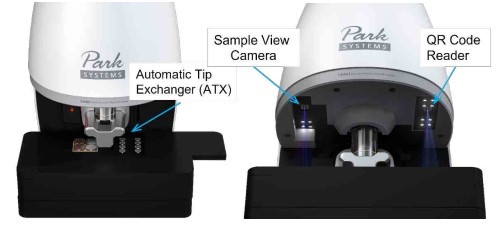
Figure 6. The main components of the FX40 system include the ATX module shown on the right and three camera modules for main view at the center, a wide-angle sample view, and QR code reader.
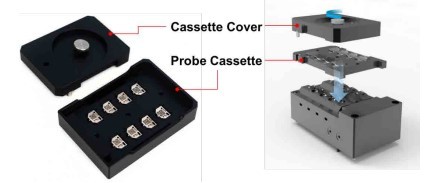
Figure 7. Probe cassette exchange is done by placing an 8-probe cassette on the top of the ATX module and unscrewing the knob of the cassette cover
Beam Alignment
In Park’s new automated beam alignment, SLD beam position is automatically aligned for accurate and proper location onto a cantilever. The SLD is attached to the optical microscope assembly and the SLD beam is always fixed at the center of optical microscope. By using XY motor adjustments of the optics stage, the cantilever can be positioned at the center of optical vision image which automatically aligns the SLD beam to the cantilever. Based on the machine learning of a probe pattern, position of a probe is found by vision recognition.
The SLD beam emerging from the objective lens is focused onto the cantilever and reflected by a steering mirror. To complete the beam-bounce alignment, two motors inside the FX AFM head adjust the angle of the SLD beam to the cantilever. Based on the machine learning of a probe pattern, position of a probe is found by vision recognition.
The SLD beam emerging from the objective lens is focused onto the cantilever and reflected by a steering mirror. To complete the beam-bounce alignment, two motors inside the FX AFM head adjust the angle of the SLD beam steering mirror, to aim the SLD beam onto the optimal location on the positionsensitive photodetector (PSPD). This automation eliminates user error during complex beam alignment process and ensures perfect alignment every time.
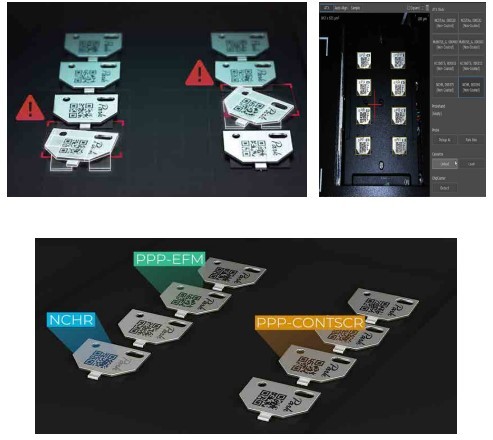
Figure 9. The QR code reader identifies the probe type by reading the QR-codes on the chip carriers in the probe cassette.
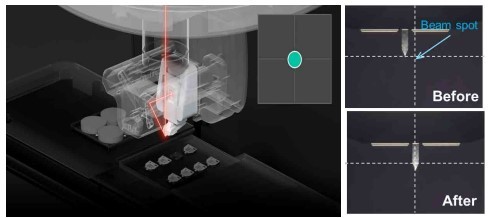
Figure 10. Due to the fixed position of the SLD, centering the cantilever in the middle of the optics immediately aligns the SLD.

Figure 11. New motorized FX AFM head optimizes the SLD beam spot position on the PSPD both vertically and laterally for optimal operation
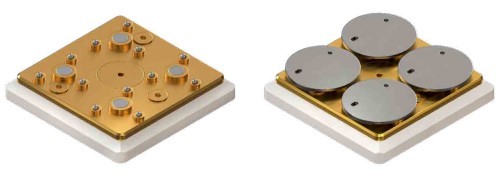
Figure 12. Multi Snap-in Sample Chuck is a default sample chuck for Park FX40. The disks are kinematically mounted to ensure good mounting repeatability
Sample Navigation
The FX40 system comes with a Multi Snap-in Sample Chuck standard. Users can populate four sample plates that are kinematically mounted. The positioning repeatability of the sample disks is 5 µm in both X and Y. Using the four sample plates with repeatable positioning, one can make easy comparison between reference and target samples, e.g., KPFM work function, SCM dopant concentration, PinPointTM nanomechanical, or SThM thermal measurements. The FX40 system uses a lowmagnification sample view camera to aid the operator navigating to the desired imaging location. As the user clicks on the optical view screen, the XY stage coordinate of the clicked position is recognized, and the XY stage moves to locate the desired measurement directly underneath the probe tip.
For fine navigation the high-resolution optical view from the on-axis main view camera can be used. After sample navigation is completed, the cantilever then automatically approaches at the selected sample location. The sample height is measured by a new auto focus module for fast and quick engagement to sample surface. The tip approach is aided by carefully monitoring the effect of air damping while the probe is approaching the sample surface. The cantilever’s vibration amplitude decreases monotonically and then linearly until the interatomic force will pull the tip to the surface at a threshold distance. This air damping effect can be used for automatic tip approach to ensure a fast but gentle tip-sample approach.
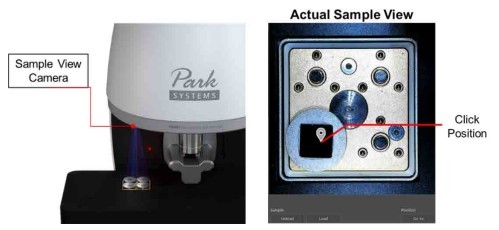
Figure 13. Sample navigation is made much easier by default off-axis sample view camera and fast moving XY stage. The picture on the left indicates the physical location of the camera while the right picture depicts an actual screen shot.
Imaging
SmartScanTM is a user-friendly interface that automates the whole imaging process and can help select imaging parameters based on objective boundary conditions and settings. It performs all the necessary imaging operations and intelligently selects the optimum image quality and scan speed [4]. This ensures consistent data quality independent of operator experience level. Processes such as the cantilever frequency sweep, operations setpoint, scan speed, or gain adjustment are part of the automatized procedures [5], reducing the time otherwise needed for manual user inputs and manipulation. Figure 15 shows the high-quality topography obtained using an NCHR cantilever, which clearly reveals Moiré patterns information of graphene on h-BN. After completing data acquisition, the software secures the system by lifting the Z stage and turning the SLD off. The used probe returns to the ATX cassette if the operator does not plan to use it right away.
Other FX Features
There are additional innovative features of Park FX40 to improve operation safety and servicing of AFM. Multiple integrated sensors measure essential environmental conditions such as temperature, humidity, sound, light, leveling and vibration near the system. The measured environmental conditions are displayed in SmartScanTM and stored in the image data, allowing the comparison of scanned images with different environmental conditions. This will provide additional environmental indicators to both users and customer service personnel. Lastly, a new and revamped head crash prevention has been developed to protect probe and AFM scanner. A dedicated circuit monitors beam deflection and Z-detector signals in real time. Safety intervention by the circuit, algorithmically programmed, provides complete protection of the AFM, the most advanced of its kind.
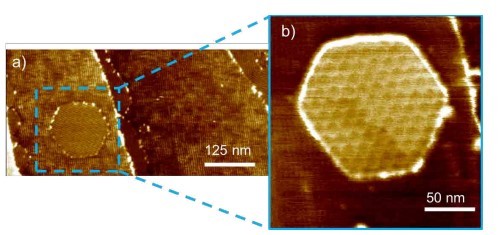
Figure 14. Moiré pattern observed on graphene on h-BN. a) Topography scan of graphene on h-BN, vertical scale 0 to 6 nm. b) Zoom in: Moiré pattern clearly visible, vertical scale 0 to 6 nm.
Summary
Park renews its product line every 10 years with a new platform, and the features and capabilities of the first product foretell the product and business strategy of the coming decade. AFM is still difficult to learn and operate for many prospective new users. Park FX40 is a new generation, research-grade, automatic AFM platform with fully automated probe exchange and beam alignment, utilizing machinelearning technology overcoming these challenges. With easy sample navigation and an intelligent scan algorithm, Park FX40 further improves performance and productivity that is now accessible to everyone, experienced and new users alike. With the Park FX40, high-definition and meaningful data can be obtained with just a few clicks.
Acknowledgement
The author wants to thank Dr. Stefan Kaemmer and Dr. Gilbert Min of Park Systems Americas for proofreading and editing the article, Rachel Bang for preparing the list of patents and publication, Kenneth Kang for the figures and schematics, and lastly Dr. Sang-il Park, founder and CEO of Park Systems Corp., for his technology vision and generous comments and feedback during product development and launch preparation of Park FX40.

Figure 15. Various sensors monitor environmental conditions of AFM measurement such as temperature, humidity, and vibration.
References
Joonhyung Kwon, Jaewan Hong, YongSeok Kim, Dong-Youn Lee, Kyumin Lee, Sang-min Lee, and Sang-il Park, “Atomic force microscope with improved scan accuracy, scan speed, and optical vision”, Rev. Sci. Instrum. 74, 4378 (2003). US 6,945,100 B2 – Scanning probe microscope with improved probe tip mount – Sep.20,2005 US 8,099,793 B2 – Scanning probe microscope with automatic probe replacement function – Jan.17,2012 US 9,645,169 B2 – Measurement apparatus and method with adaptive scan rate – May.9,2017 US 10,133,052 – Image acquiring method and image acquiring apparatus using the sample – Nov.20,2018
